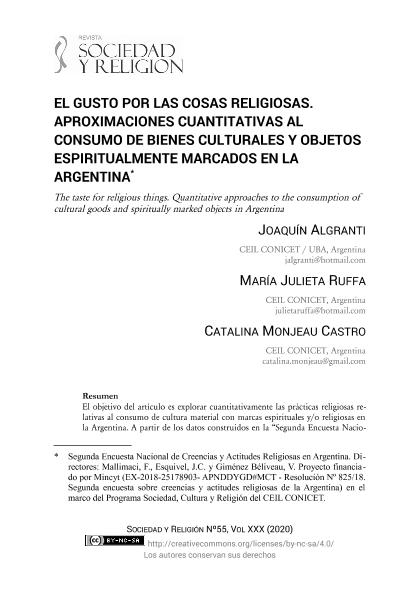Artículo
El objetivo del artículo es explorar cuantitativamente las prácticas religiosas relativas al consumo de cultura material con marcas espirituales y/o religiosas en la Argentina. A partir de los datos construidos en la "Segunda Encuesta Nacional de Creencias y Actitudes Religiosas en la Argentina" (Mallimaci, Esquivel, Giménez Béliveau & Irrazábal, 2019), analizamos tres subtipos de cultura material que diferencian sistemas de objetos y bienes complementarios. El primero abarca la cultura escrita, la cual incluye textos sagrados de distintos tipo, libros, diarios y revistas. El segundo corresponde a la cultura audiovisual compuesta por la música, los programas de radio, televisión e internet. Por último, la cultura iconográfica y estética abarca los productos de santería, la indumentaria y bisutería. El consumo de materialidades en estas tres subdivisiones será analizado en función de seis variables: la franja etaria, el género, el nivel socioeconómico, el nivel educativo, la región de residencia y el tamaño de la ciudad. De esta manera, el trabajo ofrece una caracterización cuantitativa del consumo de objetos con marcas religiosas y/o espirituales en la población argentina. The aim of the article is to quantitatively explore religious practices related to the consumption of material culture with spiritual or religious marks in Argentina. From the data constructed in the “Second National Survey of Religious Beliefs and Attitudes in Argentina'' (Mallimaci, Esquivel, Giménez Béliveau & Irrazábal, 2019), we analyze three subtypes of material culture that differentiate systems of objects and complementary goods. The first covers written culture, which includes sacred texts of different types, books, newspapers and magazines. The second includes the audiovisual culture made up of music, radio, television and internet programs. Finally, the iconographic and aesthetic culture encompasses “santeria” products, clothing and costume jewelry. The consumption of materials in these three subdivisions will be analyzed based on six variables: age group, gender, socioeconomic level, educational level, region of residence and size of the city. In this way, the work offers a quantitative characterization of the consumption of objects with religious or spiritual marks in the Argentine population.
El gusto por las cosas religiosas: Aproximaciones cuantitativas al consumo de bienes culturales y objetos espiritualmente marcados en la Argentina
Título:
The taste for religious things: Quantitative approaches to the consumption of cultural goods and spiritually marked objects in Argentina
Fecha de publicación:
02/2020
Editorial:
Centro de Estudios e Investigaciones Laborales
Revista:
Sociedad y Religión
ISSN:
1853-7081
Idioma:
Español
Tipo de recurso:
Artículo publicado
Clasificación temática:
Resumen
Palabras clave:
RELIGION
,
CONSUMO
,
CULTURA MATERIAL
,
ARGENTINA
Archivos asociados
Licencia
Identificadores
Colecciones
Articulos(CEIL)
Articulos de CENTRO DE ESTUDIOS E INVESTIGACIONES LABORALES
Articulos de CENTRO DE ESTUDIOS E INVESTIGACIONES LABORALES
Citación
Algranti, Joaquin Maria; Ruffa, María Julieta; Monjeau Castro, Catalina; El gusto por las cosas religiosas: Aproximaciones cuantitativas al consumo de bienes culturales y objetos espiritualmente marcados en la Argentina; Centro de Estudios e Investigaciones Laborales; Sociedad y Religión; 30; 55; 2-2020; 1-26
Compartir




